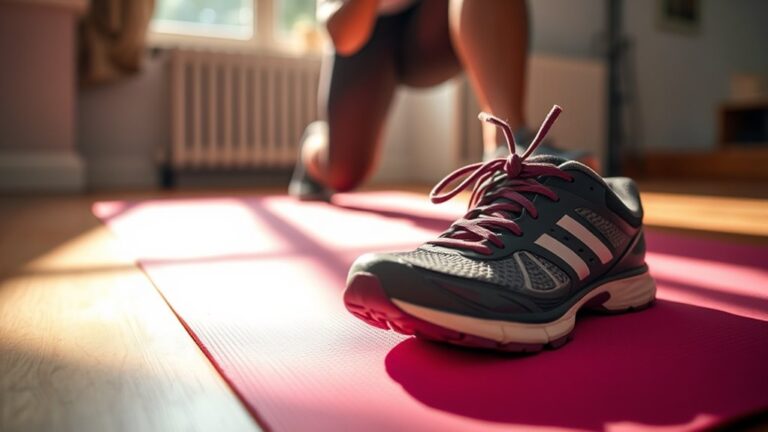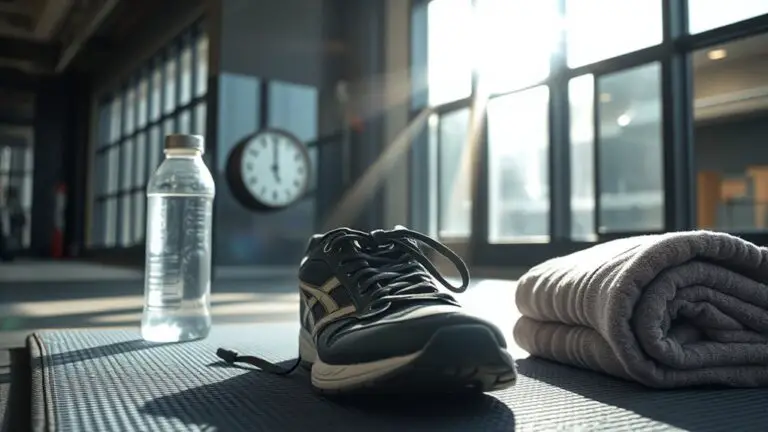The Role of Mobility and Flexibility in CrossFit Training

Mobility and flexibility are essential in your CrossFit training. They enhance your performance, allowing for deeper squats and better lifts while reducing the risk of injury. Improved mobility helps with efficient movement during complex workouts, ensuring you perform exercises correctly. By incorporating dynamic stretching and targeted mobility exercises into your routine, you’ll experience quicker recovery and sustained progress. As you focus on these elements, you’ll discover even more ways to elevate your training journey.
Understanding Mobility and Flexibility

While many people often confuse mobility and flexibility, understanding the distinction is essential for optimizing your CrossFit training. Flexibility refers to the range of motion in your muscles and joints, often enhanced through static stretching, which involves holding a stretch for a period. On the other hand, mobility encompasses your ability to move freely and easily, integrating strength and flexibility.
Dynamic stretching plays a vital role in improving mobility, as it prepares your muscles for movement through active movements, increasing blood flow and activating your nervous system. Incorporating both dynamic and static stretching into your routine can lead to significant gains in performance and injury prevention.
Benefits of Improved Mobility in CrossFit
Improving your mobility can greatly enhance your CrossFit performance and overall fitness. When you incorporate dynamic stretching and foam rolling into your routine, you’ll notice a significant boost in your movement quality. Enhanced mobility allows for better range of motion, which is essential for executing complex movements safely and effectively.
Here’s a quick overview of the benefits you can expect:
| Benefit | Description | Result |
|---|---|---|
| Increased Range | Allows deeper squats and lifts | Improved strength output |
| Injury Prevention | Reduces muscle tightness and strain | Longer, healthier training |
| Enhanced Recovery | Aids in muscle repair and flexibility | Quicker recovery times |
The Importance of Flexibility for Performance

Flexibility plays an essential role in your CrossFit performance by enhancing your range of motion and allowing for more effective movement patterns. When you’re flexible, you’re not only able to lift and perform exercises with greater efficiency, but you also reduce your risk of injury. Prioritizing flexibility training can be a game changer in maximizing your potential and keeping you in the gym longer.
Enhanced Range of Motion
Achieving an enhanced range of motion is essential for maximizing your performance in CrossFit. Improved flexibility allows you to perform movements more efficiently and effectively. To work on your flexibility, consider incorporating these techniques into your routine:
- Dynamic stretching: Engage in active movements that stretch your muscles while preparing them for workouts.
- Foam rolling: Use a foam roller to release tight muscles, increase blood flow, and improve tissue elasticity.
- Consistent practice: Make flexibility training a regular part of your regimen, dedicating time each week.
- Targeted exercises: Focus on specific muscle groups that require more flexibility for better range of motion.
Injury Prevention Strategies
While you push your limits in CrossFit, it’s crucial to remember that maintaining flexibility is a key factor in preventing injuries. Engaging in dynamic stretching before your workouts helps improve blood flow and prepares your muscles for intense movements, reducing the risk of strains. Incorporate exercises targeting all major muscle groups to guarantee balanced flexibility.
Post-workout, don’t skip foam rolling; it aids in muscle recovery and alleviates tension, promoting mobility. By regularly practicing these injury prevention strategies, you’ll not only enhance your performance but also extend your CrossFit journey. Remember, flexibility isn’t just about bending; it’s about staying strong, agile, and injury-free. Prioritize your mobility, and you’ll reap the rewards in every workout.
Common Mobility Issues in CrossFit Athletes
As a CrossFit athlete, you might encounter common mobility issues that can hinder your performance. Shoulder mobility limitations, hip flexor tightness, and ankle dorsiflexion restrictions are prevalent challenges you’ll want to address. By recognizing and tackling these issues, you can enhance your movement quality and overall effectiveness in training.
Shoulder Mobility Limitations
Shoulder mobility limitations can greatly impact your performance in CrossFit, especially as many movements require a full range of motion for ideal execution. Poor shoulder mobility can lead to issues like shoulder dislocation and compromised overhead stability. To enhance your shoulder mobility, focus on these key areas:
- Dynamic stretches: Incorporate arm circles and wall slides to warm up your shoulders.
- Strength exercises: Engage in band pull-aparts and external rotations to build stability.
- Foam rolling: Target tight areas in your upper back and shoulders to alleviate tension.
- Consistent practice: Make mobility work a staple in your routine to maintain flexibility.
Hip Flexor Tightness
Poor shoulder mobility often goes hand in hand with other common issues, such as hip flexor tightness. If you’re feeling restricted in your squats or lunges, it might be time to address your hip flexors. Tight hip flexors can stem from prolonged sitting or inadequate stretching, impacting your performance and increasing injury risk. Incorporating hip flexor stretches into your routine can greatly enhance your flexibility and range of motion. Don’t forget to focus on hip flexor strengthening exercises too; they’ll help balance your muscles and support stability during dynamic movements. Prioritize these strategies to keep your hips healthy and functioning efficiently, allowing you to maximize your potential in CrossFit and beyond. Remember, mobility is key!
Ankle Dorsiflexion Restrictions
Ankle dorsiflexion restrictions are a common hurdle for CrossFit athletes, impacting performance in key movements like squats, deadlifts, and box jumps. Limited ankle mobility can lead to compensatory patterns that increase injury risk. To enhance your dorsiflexion, incorporate these effective exercises into your routine:
- Wall Ankle Mobilizations – Push your knee over your toes while keeping your heel down.
- Seated Dorsiflexion Stretch – Sit and pull your toes toward you with a resistance band.
- Kneeling Ankle Stretch – Kneel on one knee and lean forward to stretch the ankle.
- Calf Raises – Perform raises while focusing on a full range of motion.
Prioritizing these dorsiflexion exercises will help you optimize your performance and prevent injuries. Keep pushing your limits!
Effective Mobility and Flexibility Exercises
While it’s easy to overlook mobility and flexibility in your CrossFit training, incorporating effective exercises can greatly enhance your performance and reduce the risk of injury. Start with dynamic stretching, which prepares your muscles and joints for the intensity of your workout. Focus on leg swings, arm circles, and torso twists to increase blood flow and range of motion.
Foam rolling is another powerful tool. It helps release muscle tightness and improves blood circulation, making it easier to perform high-intensity movements. Target areas like your quads, hamstrings, and calves, spending extra time on any knots you find.
Combining these techniques not only enhances your flexibility but also boosts your overall athletic performance. Remember, dedicating time to mobility work is an investment in your fitness journey. By prioritizing these exercises, you’ll be setting yourself up for success in every WOD.
Incorporating Mobility Work Into Your Routine

Incorporating mobility work into your routine is just as important as the high-intensity workouts that define CrossFit. By prioritizing mobility, you can enhance your performance and reduce the risk of injury. Here are four effective strategies to integrate mobility work:
Prioritize mobility work alongside high-intensity workouts to enhance performance and minimize injury risk in your CrossFit routine.
- Dynamic Stretching: Start each session with dynamic stretches to warm up your muscles and improve range of motion. Think leg swings and arm circles.
- Foam Rolling: Use a foam roller post-workout to release tension and improve blood flow. Focus on tight areas, like your quads and calves.
- Dedicated Mobility Sessions: Set aside time each week for targeted mobility work. Yoga or specific mobility drills can be beneficial.
- Incorporate Mobility into Workouts: Blend mobility exercises into your regular WODs. Add them between sets to keep your body flexible and agile.
Make mobility an integral part of your training, and watch your performance soar!
Assessing Your Mobility and Flexibility
Before you can effectively enhance your mobility and flexibility, it is crucial to assess where you currently stand. Start by conducting mobility assessments to pinpoint specific areas that need improvement. Common assessments include the overhead squat test and the shoulder flexion test, which reveal limitations in range of motion and stability.
Next, incorporate flexibility tests to evaluate your overall muscle length and joint function. Simple tests like the sit-and-reach can help you understand your hamstring and lower back flexibility. Remember, these assessments aren’t just for identifying weaknesses—they’re also motivational tools that can guide your training.
Once you’ve gathered this information, you’ll have a clearer picture of your body’s needs. This knowledge empowers you to tailor your mobility and flexibility work, leading to better performance in your CrossFit workouts. So, take that first step—assess your current state, and you’ll be on your way to achieving your fitness goals!
Long-term Benefits of Prioritizing Mobility and Flexibility

Prioritizing mobility and flexibility in your training isn’t just about enhancing performance in the short term; it can lead to significant long-term benefits that transform your overall fitness journey. When you focus on these aspects, you’re investing in your body’s future. Here are four key long-term benefits:
Investing in mobility and flexibility today paves the way for a healthier, more resilient fitness journey tomorrow.
- Improved Range of Motion: Increased flexibility enhances your ability to perform exercises correctly, reducing the risk of injury.
- Enhanced Recovery: Better mobility aids in faster recovery, allowing you to train sustainably over the years.
- Long-term Performance: Consistent attention to mobility can lead to impressive gains in strength and endurance, keeping you competitive.
- Injury Prevention: Prioritizing flexibility reduces the likelihood of chronic pain and injuries, ensuring you stay active and engaged in your training.
Frequently Asked Questions
How Often Should I Perform Mobility Exercises Each Week?
Imagine your body feeling light, moving with ease, and performing at its best. To achieve that, you should aim for a mobility routine at least three to four times a week. This weekly frequency allows you to enhance flexibility, prevent injuries, and improve your overall performance. Start with short sessions, gradually increasing as you feel more comfortable. Your body will thank you, and you’ll notice the difference in your training!
Can Poor Mobility Lead to Injuries in Crossfit?
Yes, poor mobility can definitely lead to injuries in CrossFit. When you struggle with mobility tests, you’re more likely to adopt improper form during workouts, increasing your risk of injury. Prioritizing mobility exercises isn’t just about performance; it’s vital for injury prevention. By improving your range of motion and flexibility, you’ll enhance your overall movement quality, allowing you to train harder and safer. So, commit to your mobility routine for long-term success!
Is Flexibility Training Necessary for All Crossfit Athletes?
Imagine a tree swaying in the wind; its flexibility allows it to withstand storms. Just like that tree, you need flexibility training to thrive as a CrossFit athlete. It’s not just about strength but also about mobility techniques that enhance your performance. Flexibility benefits you by improving your range of motion, reducing injury risk, and boosting recovery. So, yes, embracing flexibility training is essential for your growth and longevity in the sport.
What Are the Signs of Improved Mobility in My Workouts?
You’ll notice improved mobility in your workouts through a few key signs. First, you should see better range of motion during movements, allowing you to perform exercises more efficiently. If your mobility assessments show increased flexibility and reduced discomfort, that’s a great indicator too. Additionally, as you progress in your workouts, you might find that you recover faster and feel less tightness, which all points to enhanced mobility and overall workout progress.
Are There Age-Related Mobility Considerations for Crossfit Athletes?
Did you know that nearly 25% of adults over 65 experience significant mobility limitations? For CrossFit athletes, age-specific adaptations are vital. As you age, regular mobility assessments can help identify areas needing improvement. It’s important to tailor your training to accommodate these changes, focusing on joint health and functional movements. Embracing these adjustments can enhance your performance and longevity in the sport, keeping you strong and agile for years to come.




